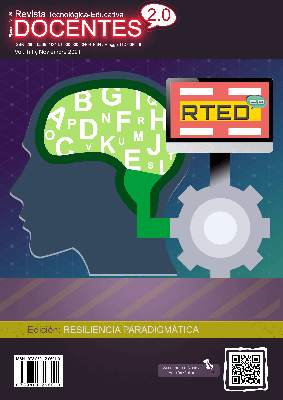Science, Technology, Engineering and Mathematics Methodology applied to the Teaching and Learning Process of Natural Sciences
 DOI:
https://doi.org/10.37843/rted.v1i1.256
DOI:
https://doi.org/10.37843/rted.v1i1.256
Main Article Content
Abstract
Globalization and the emergence of the technological era have generated changes in the most demanding trades and professions worldwide. Some have disappeared, and other new ones arise; in addition, society's problems require integral and not partial solutions, according to the areas of knowledge. The objective that guided this research was to analyze the incidence of STEM in the teaching-learning process in the natural sciences of students in the fifth year of elementary school. For this purpose, action research with a qualitative approach was developed in four phases: planning, action, observation, reflection. Learning in natural sciences under STEM methodology was limited to fifth-grade teachers and students of the public Santo Ángel Educational Institution in Bucaramanga, Colombia. For this purpose, was chosen a sample of 10 key informants, widely knowledgeable, directly related to the research, distributed in this way, one teacher director, four classroom teachers, and five students. As a result, when applying STEM as a natural science learning methodology, the students achieved good adaptability and acceptance to the work system and a significant improvement in their performance in the subject. In conclusion, the STEM approach showed overall effectiveness in the teaching-learning process of natural sciences through interdisciplinary activities.
Downloads
Metrics
Article Details

This work is licensed under a Creative Commons Attribution-NonCommercial-NoDerivatives 4.0 International License.
Those authors who have publications in our journal accept the following terms:
- When a work is accepted for publication, the author retains rights of reproduction, distribution of his/her article for exploitation in all countries of the world in the format provided by our magazine and any other magnetic medium, optical, and digital.
- Authors will retain their copyright and guarantee the journal the right first to publish their work, which will be simultaneously subject to the Creative Commons Acknowledgment License (Attribution-NonCommercial-NoDerivatives 4.0 International (CC BY-NC-ND 4.0)). That allows third parties to copy and redistribute the material in any medium or format, under the following conditions: Acknowledgment - You must properly acknowledge authorship, provide a link to the license, and indicate if any changes have been made. You may do so in any reasonable way, but not in a way that suggests you have the licensor's endorsement or receive it for your use. NonCommercial - You may not use the material for a commercial purpose. NoDerivatives - If you remix, transform, or build from the material, you cannot broadcast the modified material. There are no additional restrictions - You cannot apply legal terms or technological measures that legally restrict you from doing what the license allows.
- Authors may adopt other non-exclusive license agreements to distribute the published version of the work (e.g., deposit it in an institutional archive or publish it in a monographic volume) provided that the initial publication in this journal is indicated.
- Authors are allowed and recommended to disseminate their work through the Internet (e.g., in institutional telematic archives, repositories, libraries, or their website), producing exciting exchanges and increasing the published work's citations.
- Request of withdrawal an article has to be done in writing by the author to the Editor, becoming effective after a written response from the Editor. For this purpose, the author or authors will send correspondence via e-mail: [email protected].
- The author will not receive financial compensation for the publication of his work.
- All Docentes 2.0 Journal publications are under the Open Journal System (OJS) platform at: https://ojs.docentes20.com/.
References
Borromeo, R., Mena, J., & Mena, A. (2021). Fomento de la Educación STEM y la Modelización Matemática para profesores. Alemania: Kassel University Press. https://doi.org/doi:10.17170/kobra-202106174132
Caicedo, L., & Acuña, M. (2015). Miniproyectos: Una Estrategia Metodológica Basada en la Enseñanza para la Comprensión (Epc). En Las Ciencias Naturales Experimentales De Escolares. Repositorio Institucional UNAB. http://hdl.handle.net/20.500.12749/2285
Deirdre, E., Debby, M., Junie, B. K., & Marnie, F. (2020). Juegos STEM en los Rincones de Aprendizaje (1ra ed.). NARCEA S.A.
Elliot, J. (2000). La Investigación Acción en la Educación. Morata.
Espinosa, J. B. (2018). STEM Introducción a una nueva forma de enseñar y aprender. En J. B. Espinosa. STEM Education Colombia.
García, S. (2015). Metodologías didácticas para la enseñanza y aprendizaje de las ciencias naturales en zonas rurales del municipio de Obando – Valle del Cauca. https://repositorio.unal.edu.co/bitstream/handle/unal/53550/Tesis%20Sair.pdf?sequence=1&isAllowed=y
Giraldo, F., Molina, J., & Córdoba, F. (2018). Desarrollo y Transformación Social desde Escenarios Educativos. Fondo Editorial ITM. https://books.google.com.co/books?id=swFgDwAAQBAJ&pg=PA49&dq=STEM+AUTORES&hl=es-419&sa=X&ved=2ahUKEwjP3eecy6DzAhV-SjABHb_mCSw4ChDoAXoECAQQAg#v=onepage&q=STEM%20AUTORES&f=true
Gualteros, N. (2018). Estrategia pedagógica de integración de la educación ambiental a las áreas de español, sociales y ciencias naturales para los estudiantes de grado 2°1 del Instituto Comunitario Minca Sede C de Floridablanca: Una mirada transdisciplinar. Universidad Santo Tomás. https://repository.usta.edu.co/bitstream/handle/11634/16311/2019nohoragualteros.pdf?sequence=1&isAllowed=y
Kelley, T., & Knowles, J. (2016). Un marco conceptual para la educación STEM integrada. Revisa Internacional de Educación STEM. https://doi.org/10.1186/s40594-016-0046-z
Lee, J., & Strobel, J. (2014). Ingeniería en entornos preuniversitarios: síntesis de investigación, políticas y prácticas.
MEN. (2004). Mineducación. https://www.mineducacion.gov.co/1759/articles-81033_archivo_pdf.pdf
Michael, C., Cary, S., & Jo Anne, V. (2013). STEM Lesson Essentials. En C. S. Michael Comer, STEM Lesson Essentials. Heinemann.
Ortega, F. J. (2007). EDUCREA. https://educrea.cl/modelos-didacticos-para-la-ensenanza-de-las-ciencias-naturales/
Ruiz, V. (2007). Diseño de proyectos STEM a partir del currículo actual de educación primaria utilizando aprendizaje basado en problemas, aprendizaje cooperativo, Flipped classroom y robótica educativa. Universidad CEU Cardenal Herrera. https://repositorioinstitucional.ceu.es/handle/10637/8739
Sandoval, C. H. (2020). La Educación en Tiempo del Covid-19 Herramientas TIC: El Nuevo Rol Docente en el Fortalecimiento del Proceso Enseñanza Aprendizaje de las Prácticas Educativa Innovadoras. Revista Tecnológica-Educativa Docentes 2.0, 9(2), 24–31. https://doi.org/10.37843/rted.v9i2.138 DOI: https://doi.org/10.37843/rted.v9i2.138
Serrano, G. P. (1994). Investigación Cualitativa. Retos e Interrogantes. La Muralla S.A.
Unesco. (2017). Descifrar el Código: La Educación de Niñas y Mujeres en STEM. Unesco. https://books.google.com.co/books?id=8jOIDwAAQBAJ&printsec=frontcover&dq=educaci%C3%B3n+STEM&hl=es-419&sa=X&redir_esc=y#v=onepage&q=educaci%C3%B3n%20STEM&f=false






